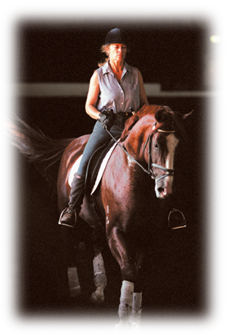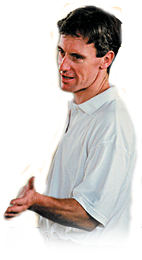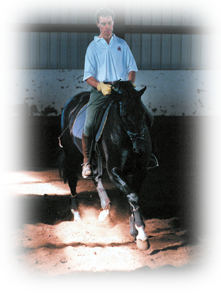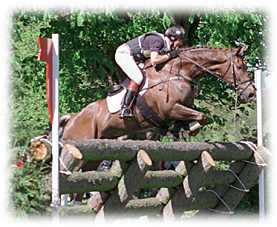Christopher Bartle’s method of training is mentally demanding for the rider, whilst challenging the horse athletically. The many exercises that make up Christopher’s own personal system are well-tested on his international dressage horses and eventers… and what’s more, they work! ANN-MAREE LOUREY sat in on a three-day clinic, while PETER STOOP took the pictures.
Christopher Bartle deserves full credit for physical fitness and mental agility – he was still performing flying changes on foot on the third day of his clinic at the NSW Equestrian Centre at Lochinvar despite the 36-degree heat. In stark contrast, a rather obvious lethargy was beginning to steal over even the most devout of his faithful onlookers, lulled towards sleep by the sound of cicadas outside.
While his Yorkshire home was no doubt buried in snow, Christopher was taking his annual New Year holiday Down Under, sharing some European experience with us all.
And the participants in the clinic? Well, fair to say that the 40-minute lessons flew by, the riders emerging feeling not so much physically exhausted but mentally challenged, with new ideas and thought-provoking exercises fighting for mind space. If nothing else, Christopher’s system demands a split-second knowledge of what every leg of the horse is doing at every moment of every pace. And then you need to put that knowledge to good use…
The three-day clinic showed clearly that the Bartle emphasis was on a more athletic horse – almost every horse appeared tired after its lesson, despite it being probably a shorter work-out than its usual daily session – but none showed heaving flanks and dripping tummies. Instead, it seemed that they had been gymnastically challenged as together Christopher and the rider worked muscles that the horses had successfully kept hidden from reach!
And that might also have applied to some of the riders, since Christopher worked on their position as well, and innocently asked what they did to train.
“I don’t think people appreciate sometimes what bloody hard work it is to keep the posture correct,” he says. “Even riders find it difficult. I’ve had many riders who collapse in their posture every time I halt them – they just can’t hold it for a long period of time.”
“I do the riders’ posture and the horses’ posture, the one is nothing without the other. I am always working on the rider in relation to the horse, I don’t ever put a rider on a horse and work on their posture and not care how the horse is going. The whole idea of you having a posture is to say to the horse: ‘I’m like this, you be like that.’ My priority would be getting that expression and posture and so on, and then can I carry that through into the movements.”
“I am very interested in developing the posture of the horse, that’s really what dressage, I think, is all about. The movements and so on are a secondary issue, they are the proof of the pudding. To get the flamboyance and expression in the movements you have to have the posture, and I think that’s probably where riders here in Australia go slightly wrong. They get the movements first and then try to get the posture, the expression, second. Some people are fortunate enough to buy horses that already have that ‘wow’ posture and movement so it’s slightly easier for them. The only issue for them is will they, in the process of teaching them the movements, destroy the posture?”
Christopher is very much against over-use of the seat.
“I think that if you thought of it in terms of a physical structure, like you were sitting on a piece of furniture, a flimsy piece of wood, and you did the same thing, you pushed with your seat, you could imagine that piece of wood bowing downwards as you drive into it and I think that’s what the horse’s back does,” he explains.
“As the horse’s back dips away from the rider’s pressure of seat, the neck does the opposite, it comes up, and the croup comes up behind, and the rider feels that slight hollowing so then they tighten on the rein, and the horse then gets a resistant jaw, and then you get the tension in the poll and all those sorts of things.”
“So I think most of those problems can be resolved if the rider, instead of at that point in time driving with the seat, recognises that the horse is hollowing with his back, lightens the seat slightly, lets the back come up, and once the back has started to round it’s only a small degree that’s required to come up instead of down, then the horse has the possibility of rounding his loin, for his hindleg to come under the body and therefore the neck to draw forward and be soft.”
“People do tend to misunderstand the textbooks that talk about driving the horse into the outside rein.”
“I have this little analogy I keep using on riders who push with the seat, particularly in the trot, and I say it reminds me of my son Thomas when he was a baby, pushing the potty across the kitchen floor, creeping across, and if you do that on a rickety piece of furniture you will break it in no time.”
(It’s not until after the lessons are done for the day that you discover that baby Thomas is now 12! How he must love to hear it…)
Position corrected – and Christopher is not into the ‘longer the stirrup, the better it must be for you’ mentality, insisting that if the stirrups are too long then in fact it makes it more difficult for the rider to get the leg on the horse – the lessons move into real work.
Christopher begins all levels in the walk and moves on to trot, before making trot-walk transitions. To begin, he wants to see rising trot to walk, making sure that the rider walks on the rise step, producing a seamless transition. Then there are transitions within the trot and eventually on into sitting trot for the lateral work.
But not for Christopher endless circles with the odd change of rein.
To begin, there is barely a circle of trot before a transition back to walk and a turn about the forehand out of the circle, to begin again in rising trot in the new direction.
“When I am walking I start to think about my timing and I think ‘now, now’ (inside fore) and then I think ‘now, now, now, trot!’,” he says.
“I want to see that you are able to maintain the rhythm throughout the rising trot. And then you need to keep the rising trot thought in your sitting trot, so you can still walk on the rise step. Why walk on a rise? It’s the moment the inside hindleg comes under the body, it takes a good step forward under his body.”
“You are trying to develop the expression, the impulsion of the trot, without the speed. You are asking the horse to step a little bit slower and a little bit higher. You are trying to do it in a light contact, trying to keep the neck straight.”
“I have christened this ‘the zone’, the zone between trot and walk, and you should be able to stay in that zone as long as you like or as little as you like. The closer you get to walk, the higher you rise.”
“As you get closer to walk and you have a softer contact you start to get a little bit more cadence.”
“And when you are sitting the trot, think of sitting on his back as sitting on eggshells. You have to imagine that the horse cost you half a million dollars from Germany… keep him soft through the jaw, make sure you don’t get left behind. Think that you are 6ft tall, think all the time 1, 2, 3, 4 …1, 2, 3, 4 … and now come into the zone again! Don’t thump on his back, sit gently.”
“One of the key steps is that when the horse moves from walk to trot, it is a coming-under step and not a pushing-forward step.”
“If you are going to use your whip, do it on the rise, behind your outside leg. Give a little vibration on the outside rein but don’t pull on the rein when you do it. Touch with the whip behind your leg as you rise. Use your outside rein as the outside foreleg comes back, use the leg as the outside shoulder goes forward. Your outside rein says ‘shorter step’.”
“Your body language says ‘This is what I want’.”
“Go into a little medium, then bring him back to the zone, and soften your hand and come into walk.”
“Use your body, saying ‘Come on, you can do it’, not pulling more, not driving harder.”
“Lean forward a bit, and let his back come up to you. A ‘pose-y’ trot is not what we want.”
“Every time you rise you are saying: ‘Sit up, stretch up!’. When you sit, try to close your leg so that he comes higher, don’t lean forward and give the rein back to him. Say ‘sit up, sit up’ and close your leg as you sit in the rising trot.”
“You have to take an attitude of ‘listen, listen’ and if that means a step or two of reinback really engage the inside hind then do.”
“Every time you are rising you are saying ‘get up to the bridle, get up to the bridle’ and as you trot you are thinking ‘hup, 2, 3, 4, hup, 2, 3, 4, without getting faster. Give a little check on the outside rein but don’t hang onto it.”
“Separate your hands if the horse is unsteady in the contact, and once he’s steady bring your hands back together. Don’t do anything sudden, keep the timing correct and over a number of strides come back to the shorter step. Think of your arms as pieces of elastic that are soaking up the contact all the time.”
“Stretch up, grow bigger, think bigger. Your posture says to your horse what you think of him. Keep light hands and carry your posture.”
“Have a loose hip, a loose thigh, have fresh air passing under your leg occasionally. And what are you going to do if you can’t keep that fresh air there? Halt, maybe reinback, go off into trot with light hands, do maybe five steps of medium and come back. Be quicker with your hands when you come back, don’t hold on to him, do quick signals that say ‘listen’. You need little actions, then he can’t pull you over the front. How many steps can you maintain light? How many steps of medium can you do with him light? Do lots of little medium trots rather than one big one, almost rattle the bit as you come back to make sure he is listening.”
“But always you are looking for a bit more cadence in the trot. If he tries to take the rein from you, you tighten your elbow against your body, if he tries to drop the contact you separate your hands. If he starts to curl up on one side or the other you just separate your hands again. We are waiting for him to accept the bit and come steady on the contact in the shorter trot.”
“When you have horses that are not consistent in the contact, and most young horses are not, so one minute they are pulling at you, then they’re dropping the bit, then they’re coming above the bit, then they’re going behind the bit, all sorts of different expressions we use for the same thing, which is lack of confidence in the contact to a degree, lack of their posture, again, their posture is weak so it affects their neck.”
“Anyone can try it, hold a brick out away from your body and see how long you can do it… your arm soon gets tired, so you bring your hand closer to your body, and that’s what a horse does with his neck. It’s not easy for a horse to carry his neck out in a raised and arched appearance for long, so lots of weak horses, young horses, Thoroughbred horses, will shorten the neck, either drop too low, drop in too much or come up and back like a sheep.”
“We have to look to ourselves and say ‘what is our job, what can I do?’ I could just try to maintain a constant elastic contact and wait for them to change their mind – in other words, every time they drop it I take it up for them, I motivate them, I encourage them, I try to keep the rhythm, I say ‘come on’ as I rise, but I try to keep the rhythm. They’re not allowed to run faster so then I say ‘slow down’ when I sit, until I feel that they have accepted the contact.”
“And you get that feeling partly from the fact that they start to maintain the rhythm, partly from the fact that you get a feeling that they go quiet in the mouth and draw the neck forward into the contact.”
“At that point in time you say thankyou, and that thankyou would either be to come through into walk or go on in a stronger trot. The separating of the hands is a way of first keeping them straight, head-neck-withers-body-hips-tail, all in line, and it is a way of taking up the slack in the contact that they are dropping in a way that doesn’t pull your elbows back. And as they draw that contact forward and go into it again, it automatically brings your hands back together again. That’s the theory behind it. Because as they draw forward into the contact they also stretch themselves straighter so you don’t have that channelling problem that you had before.”
“Again, talking about that elastic contact, one of the points I am making to riders, particularly with horses that are fussy in the mouth, very reluctant to accept a contact, is that you try your best to present a soft continuous contact to them and they’re still champing around, Thoroughbreds particularly or horses that have had a mouth problem.”
“I’ve had many occasions where the horse that has been a particularly difficult one in the mouth, so we’ve tried taking a piece of elastic and instead of riding them on reins we ride them on elastic, about an inch wide. You have to be fairly brave, and if you want to you can have your other rein there as a sort of fail-safe and you ride them round on the piece of elastic.”
“To start with the horse feels the piece of elastic, feels the fact that there is a contact and tries to either drop it or snatch it or move the head around and what they find is that wherever they go, the contact is there and eventually they stop doing it because there isn’t any point in doing it. When you have a horse that’s fussy, you try your best to be elastic but no matter how much you try you are never quite as elastic as a piece of elastic.”
“It’s worked very well in a lot of cases, that’s how I first of all started to use the elastic, but then I started to use it as well with some riders to get them to realise how light their horse ought to be, to feel that it ought to be possible to ride your horse on the piece of elastic. And so you give them two reins, their leather rein and a piece of elastic, and you say ‘by all means use your leather rein to give a half halt, but get back on the elastic straight away until your horse will go in the right position with the right attitude on that piece of elastic’.”
“It’s probably a dream that is darn nigh impossible to achieve or attain unless it’s a fairly strong piece of elastic, but there must be, for each horse, a certain pounds of weight in the rein that you are looking for as the ideal and you could get a piece of elastic that would give you that.”
“You need the leather rein to say to them ‘listen’, to make the half halt quick enough, but with the objective that you get back to a lightness, a consistency of contact.”
A very full life…
Christopher Bartle is a busy chap. He juggles the job of managing director of the Yorkshire Riding Centre in Britain with the role of official trainer to the British three-day event team. He was a member of the gold medal-winning British eventing team at the European championships in 1997 and he won Badminton in 1998.
That’s a track record that sounds impressive enough, but that’s not all!
Prior to Christopher’s eventing triumphs, he was a dressage star, being the highest-ever placed British dressage rider at an Olympic Games – 6th at the Los Angeles Olympics in 1984 on Wily Trout. And it was no fluke – the following year he was fourth at the European Championships.
Most people retire from eventing to concentrate on dressage, but Christopher has done it the other way round, and doesn’t dismiss the possibility that he will yet come full circle.
In fact, his chequered career has also included race riding, but he knows he won’t be going back to that.
“I spent a year in France before I went to university and I was lucky enough to spend it in Chantilly (a fair equivalent of Newmarket), with a chap called Commandant Braisot, who before he retired was the chief instructor at the Cadre Noir in Samur,” Christopher recalled. “He was a very elegant rider, a role model. You wished you could be as good as he was. He was the picture in my mind!”
“I spent a year there and I rode and rode and rode, every hour of the day, had some lessons as well as riding on my own. That sold me a bit on dressage, and I was jumping a bit, but mainly I was impressed by the dressage.”
“Then I went to uni and while I was at uni I got riding for some friends who were just outside the city, outside Bristol. They had racehorses, hunters, dealer horses, all sorts, and I got away from the dressage side of things. I used to school their horses and try to make them better, but my main thrill there was racing and hunting.”
“I got really into racing, and did four seasons as an amateur jockey in national hunt racing, steeplechase, hurdle racing and so on, riding against the professionals. But I’m too tall, I weigh about 11 stone now. To get rides at that time I had to weigh 28 pounds less than I do now – it was ridiculous.”
“I did get some rides but they weren’t brilliant rides, I had the odd winner and placing and so on but after a few years of doing that it was too much like agony.”





